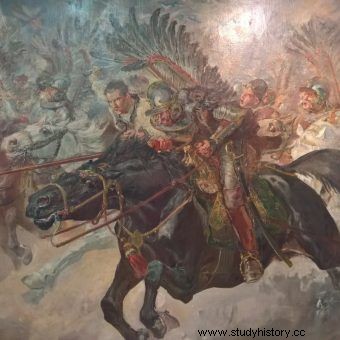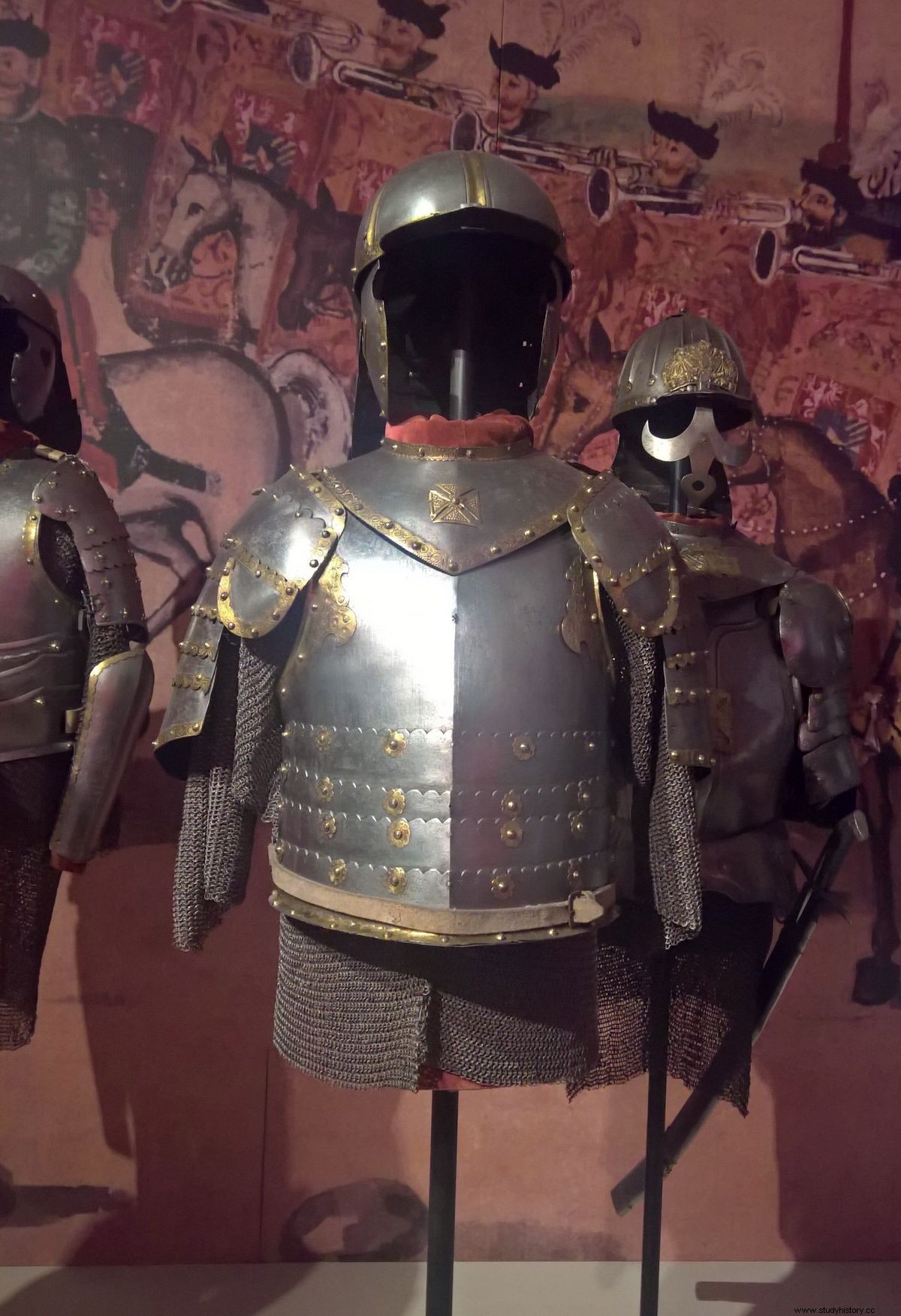Probably nothing is associated with the hussars more than this unusual piece of equipment. However, it arouses a lot of controversy among scientists. Time to finally decide:where and why the legendary riders wore wings?
Nobody doubts that the hussars used their wings in parades. On the other hand, there has long been a debate about whether they were used in battle. After years of studying this subject, contrary to the skeptical opinions of some historians, I have no doubt today that wings were also worn in combat.

Did the hussars use wings in combat? Or maybe they were just decorations?
The number and quality of the source material that speaks of the combat use of wings is simply too great, and they are credible, so you cannot dismiss them all.
The Fear of the Enemy
Feathers - including their special form, which were wings - worn by riders and their horses served both for their own "splendor" and for "the terror of the enemy." Wings, feathers, feathers made those who wore them seem more powerful.
In the military treatise by Stanisław Łaski, written in the years 1544–1545, we read:"But with the hetman's will and careful attention it comes that sometimes the troops have to be decorated, stretched, feathered to make it appear more important from the small post office." The same was written in 1575 by the Venetian envoy, Girolamo Lippomano:
[Poles] use all means during hostilities to show that [there are] as many as possible to scare the enemy, they have themselves as and on horses, infinite feathers, [wear] eagles' wings, leopard skins and bear skins.

To scare the enemy, the hussars put on the skins of predatory animals and attached their wings. This can be seen, among others, in this fragment of the 17th-century painting by Marcin Altomonte "The Battle of Vienna".
When the opponent seems larger or more numerous, people subconsciously evaluate their chances of winning lower. In other words, they are more afraid. And as already mentioned, the "moral factors" during the clash were one of the most important. The wings, however, did not scare only the soldiers. First of all, they scared the enemy's steeds.
Horses are naturally shy animals. When they encounter a new, so far unknown phenomenon, their reaction is very often to run away. There were times when Poles used it in a rather peculiar way. According to the account of a French resident in Poland in 1681:
Serving the [mail] of these people [ie. hussar companions] preceded by a banner on horseback with a lance in hand; and what is quite peculiar is that they have wings attached behind their backs, when the opportunity arises they penetrate the enemy's ranks and scare enemy horses that are not used to such sights, and make room for their masters who follow them ( …).
It should be added here that the wearing of wings by postal officers was sanctioned by the Hetman's regulations of 1746 (...). And as in the 17th century, in the 18th century, the wings of the post office were supposed to scare the enemy's horses with their sight. In 1735 Johann B. Steinhäuser wrote:
Each companion or hussar has his armed servant with a musket [bandolet / rifle] behind him, he is also in armor and wears a wolf skin on his shoulder, and a big an eagle's wing between the shoulders, all this to frighten horses that are not at all used to the spectacle and noise that a similar unit causes when rushing.
For protection?
It is sometimes claimed that the wings were supposed to protect the hussars from cutting with broadswords. The source of this is the account of Cardinal Hippolytus Aldobrandini, written at the end of the 16th century.

Polish winged horseman (probably a Tatar) in 1627 (Abraham van Booth, Journael van de Legatie in Jaren 1627 en 1628, Amsterdam 1632). The illustration and caption come from the book "Husaria. The pride of Polish arms ”,
However, he wrote about Polish Tatars, not about hussars:
Later we met a large detachment of the Tatar cavalry, made up of brave and fearless people, and in fact it was evident from their faces that they were so. They had a saber at their side, bows and sajdaki hanging on their shoulders, weapons they simply use when they clash with an enemy in disarray. They were well dressed, many with silk cloth, with wings on their backs to scare horses when they fell into enemy ranks, and which also serve them as a defense against cutting with broadswords.
Note that he also puts the matter of scaring horses off with his wings first. He treated broadsword protection as an additional advantage, which was important for riders who did not wear armor. And that's what the Tatars were like. When the rider used such armor, he did not need a wing to protect his back.
So did the protective role of the wings not matter to the hussars? After all, the hussars were supposed to wear armor. And they did, but not always and not everyone. Françoise Paulin Dalerac, a French courtier of Jan III Sobieski and Maria Kazimiera, who stayed in Poland for several years (with breaks), noted that:
[…] Pachos, or to the Post Office; the gentlemen who have a similar copy, y Szyszaki, y Zbroie; but without cuirass, and without leopard skin. Instead, they have fur, made of a white wolf, made in the shape of a caftan, and in the back, a very large wing, accomodated from eagles' feathers. This is what makes them so terrible that they are cruel. Before that, they had two Wings, and as can be seen, in Pictures, the old Woiens.
As you can see, the wings could also protect the hussars from being cut from the back with the broadsword - those hussars who did not wear armor. Interestingly, Dalerac explained the purpose of the wings in a different way than the sources quoted.

Not all hussars wore armor. The photo shows Hussar armor from the collection of the National Museum in Krakow.
It is true that he also writes that they were supposed to frighten the horses, but not with their sight, but with noise:
Using such Wings, I don't find useful; but only have them for this, call on; that the rustling [em] which these wings make in the air frighten the Unkind horses through which the Forms intermingle.
Noisy angels
The Italian Sebastiano Cefali also wrote about the noise made by the Hussar wings in 1665:"In the back [Hussar companions] they used to carry two large vulture wings, which in their rush [caused] great noise."
The visual and auditory stimuli could complement each other very well, though he wonders if the hum of the wings could penetrate the beat of galloping horses, the whirr of pennants attached to the lances, and the jaws of armor.
What else were the wings to serve? Here and there there are claims that the wings were used to make the hussars resemble angels, or to protect them from the Tartar arcana. However, I have not been able to find sources from the 16th-18th centuries that would justify these claims (...).
"Strangely beautiful sight"
[It is also worth explaining exactly how the wings looked like]. First, the wings were not only carried on the back, but also tied to the saddles, attached to the helmet and shields. Second, when worn on the back, a backrest was not always needed for attachment, as the wings were also used by riders who did not wear protective gear. Third, the wings did not have to be used in tandem. They were often single. Fourth and finally, their design also varied greatly.
They could be wooden slats (of various lengths and shapes) with feathers inserted into them. They could have been zoomorphic wings, resembling real bird wings (…).
The diversity that prevailed in this area was testified by Paweł of Aleppo, who in the 1750s traveled around the territory of the Republic of Poland, writing:"To this day [Poles] adorn their armor and horses with the wings of great birds.

In the middle of the 17th century, Paul of Aleppo also wrote about hussar wings. The illustration shows the hussars' charge under Kircholm according to Wojciech Kossak.
It was also confirmed by the invaluable Jędrzej Kitowicz, who noted that during the reign of August III the Saxon (in the years 1733-1763), when the Hussar 'commandant' in Poland dressed in ostrich feathers attached to a helmet:
Instead of ostrich feathers, the Hussars [ie. Postmen] had wood bolted to the armor from the waist above the rows of heads high, curved above it, with feathers long from end to end in rows, infused with various colors with feathers painted, a laurel or palm branch imitating, which made a strangely beautiful sight.
Source:
The above text was originally published as part of the book by Radosław Sikora "Husaria. The pride of the Polish army ” (Horizon 2018 sign).
The title, lead, illustrations with captions, bolds and subtitles come from the editorial office. The text has undergone some basic editing to introduce more frequent breakdown of paragraphs.
